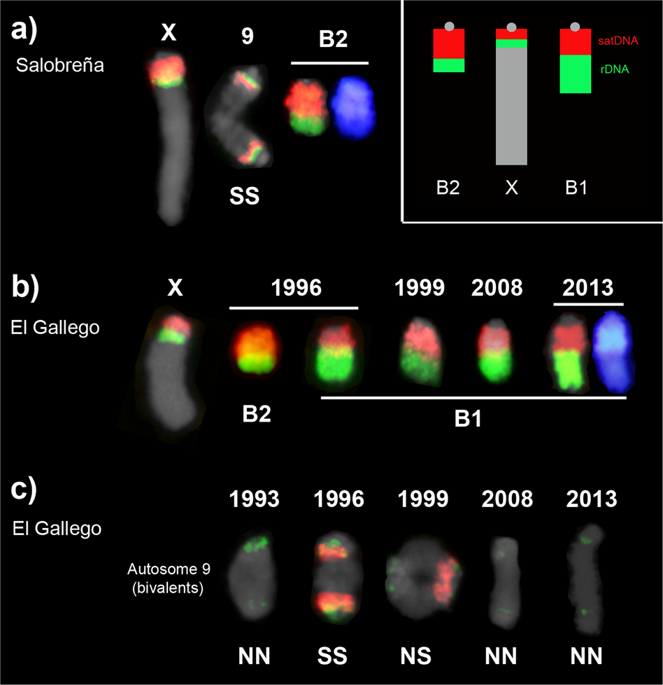Our official English website, www.x-mol.net, welcomes your
feedback! (Note: you will need to create a separate account there.)
Interpopulation spread of a parasitic B chromosome is unlikely through males in the grasshopper Eyprepocnemis plorans
Heredity ( IF 3.1 ) Pub Date : 2019-07-08 , DOI: 10.1038/s41437-019-0248-5 María Inmaculada Manrique-Poyato 1 , Josefa Cabrero 1 , María Dolores López-León 1 , Francisco Perfectti 1 , Ricardo Gómez 2 , Juan Pedro M Camacho 1
Heredity ( IF 3.1 ) Pub Date : 2019-07-08 , DOI: 10.1038/s41437-019-0248-5 María Inmaculada Manrique-Poyato 1 , Josefa Cabrero 1 , María Dolores López-León 1 , Francisco Perfectti 1 , Ricardo Gómez 2 , Juan Pedro M Camacho 1
Affiliation

|
The near-neutral model of B chromosome evolution predicts that population invasion is quite fast. To test this prediction, in 1994, we introduced males of the grasshopper Eyprepocnemis plorans from a B-carrying population into a B-lacking population and monitored the evolution of B-chromosome frequency up to 2013. We observed fluctuating very low B frequency across years but, remarkably, the B chromosome introduced (the B2 variant) was found up to 1996 only, whereas the B1 variant was present from 1996 onwards, presumably introduced by fishermen using E. plorans males as bait. Effective introgression of genetic material from the donor population was evidenced by the presence of a satellite DNA on autosome 9 (up to 1999) and the presence of one individual in 2006 showing an ISSR marker profile being highly similar to that found in the donor population. This indicated that the males introduced by us effectively mated with resident females, but donor genes rapidly decreased in frequency after this non-recurrent migration event. Taken together, our results indicated: (i) that the non-recurrent migration event had a slight, transient genetic effect on the recipient population, which was diluted in only a few generations; and (ii) that even with recurrent migration (forced by fishermen) the B chromosome failed to increase in frequency. Bearing in mind that B chromosomes in this species drive through females only, we hypothesize that B chromosomes most likely failed invasion in both migration events because the migrating sex shows no B-drive.
中文翻译:

寄生 B 染色体不太可能通过雄性蚱蜢 Eyprepocnemis plorans 进行群体间传播
B染色体进化的近中性模型预测种群入侵速度相当快。为了验证这一预测,我们于 1994 年将雄性蝗虫 Eyprepocnemis plorans 从携带 B 的种群引入到缺乏 B 的种群中,并监测了截至 2013 年 B 染色体频率的演变。我们观察到 B 频率跨年波动非常低但值得注意的是,引入的 B 染色体(B2 变体)直到 1996 年才被发现,而 B1 变体从 1996 年开始就存在,可能是由渔民使用雄性 E. plorans 作为诱饵引入的。常染色体 9 上卫星 DNA 的存在(截至 1999 年)和 2006 年一个个体的存在证明了来自供体群体的遗传物质的有效渗入,该个体的 ISSR 标记谱与在供体群体中发现的高度相似。这表明我们引入的雄性与常驻雌性有效地交配,但在这种非经常性的迁徙事件之后,供体基因的频率迅速下降。总而言之,我们的结果表明:(i)非经常性迁徙事件对接受群体产生了轻微的、短暂的遗传影响,这种影响仅在几代人的时间内就被稀释了; (ii) 即使反复迁移(渔民强迫),B 染色体的频率也未能增加。考虑到该物种中的 B 染色体仅通过雌性驱动,我们假设 B 染色体很可能在两次迁徙事件中都未能入侵,因为迁徙的性别没有表现出 B 驱动。
更新日期:2019-07-08
中文翻译:

寄生 B 染色体不太可能通过雄性蚱蜢 Eyprepocnemis plorans 进行群体间传播
B染色体进化的近中性模型预测种群入侵速度相当快。为了验证这一预测,我们于 1994 年将雄性蝗虫 Eyprepocnemis plorans 从携带 B 的种群引入到缺乏 B 的种群中,并监测了截至 2013 年 B 染色体频率的演变。我们观察到 B 频率跨年波动非常低但值得注意的是,引入的 B 染色体(B2 变体)直到 1996 年才被发现,而 B1 变体从 1996 年开始就存在,可能是由渔民使用雄性 E. plorans 作为诱饵引入的。常染色体 9 上卫星 DNA 的存在(截至 1999 年)和 2006 年一个个体的存在证明了来自供体群体的遗传物质的有效渗入,该个体的 ISSR 标记谱与在供体群体中发现的高度相似。这表明我们引入的雄性与常驻雌性有效地交配,但在这种非经常性的迁徙事件之后,供体基因的频率迅速下降。总而言之,我们的结果表明:(i)非经常性迁徙事件对接受群体产生了轻微的、短暂的遗传影响,这种影响仅在几代人的时间内就被稀释了; (ii) 即使反复迁移(渔民强迫),B 染色体的频率也未能增加。考虑到该物种中的 B 染色体仅通过雌性驱动,我们假设 B 染色体很可能在两次迁徙事件中都未能入侵,因为迁徙的性别没有表现出 B 驱动。











































 京公网安备 11010802027423号
京公网安备 11010802027423号